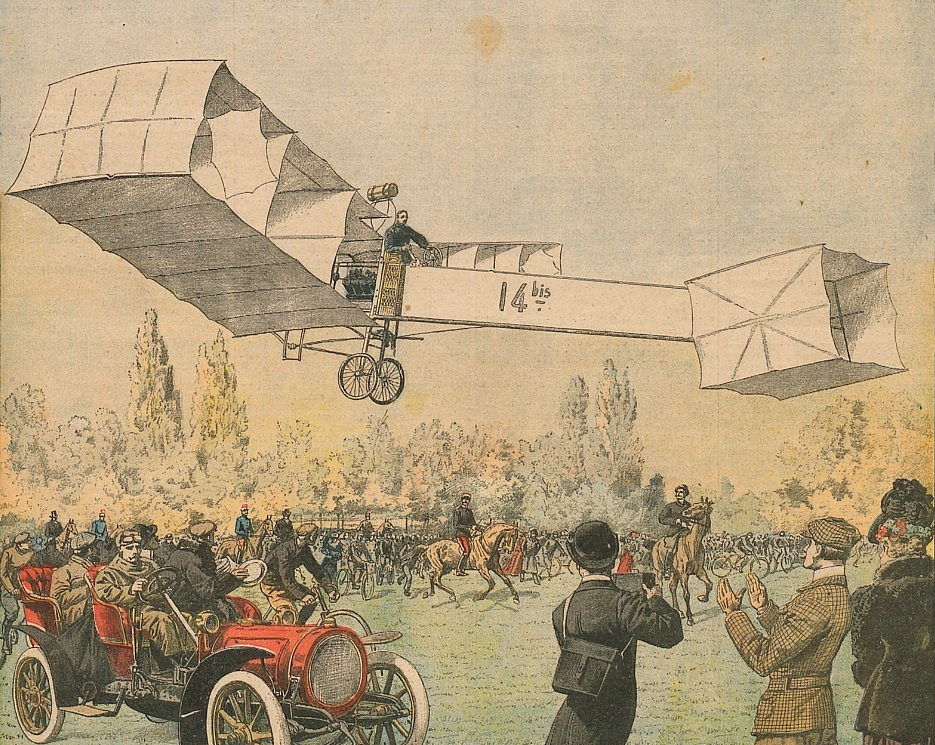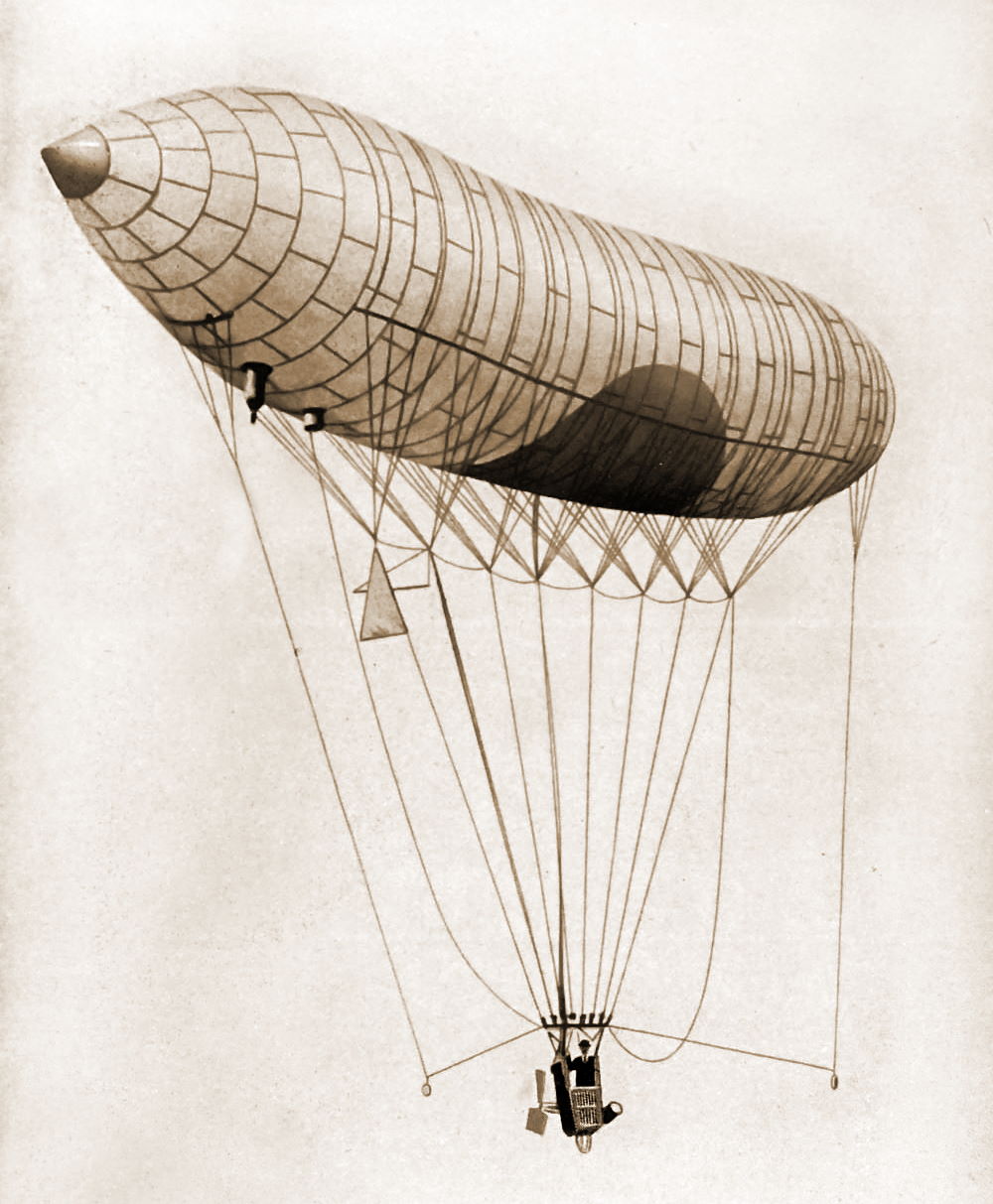The Wright brothers are generally considered to be the inventors of flight, but in Brazil, it is their son of the soil Alberto Santos-Dumont who is widely celebrated as the “father of aviation”. But why is that so?

The flight of the Santos-Dumont 14-bis on the cover of Le Petit Journal, 25 November 1906.
Who was Alberto Santos-Dumont?
Alberto Santos-Dumont was born in 1873 to a wealthy Brazilian coffee magnate. From his early childhood, Santos had a great love for mechanical things. He drove the farm's locomotives, observed the coffee machines on the plantation, and made repairs while still a child. At night, he would lose himself in the fictional adventures of Jules Verne. Verne’s stories planted in him a desire to conquer the air, and he began imagining and building little mechanical devices such as kites and small airplanes powered by a propeller driven by twisted rubber springs.

When he was 15, Santos saw his first human-powered flight in São Paulo where an aeronaut ascended in a spherical balloon and parachuted down. Ten years later, Santos made his first balloon ascent in a rented balloon. In the following months, Santos began making his own balloons. The first one measured a mere 6 meters in diameter and weighed only 27 kilograms. It was the smallest aircraft ever built until then, yet, it flew more than two hundred times.
When Santos turned a little older he turned his attention to dirigibles, replacing the heavy electric motors with a lightweight 3.5 horsepower internal combustion engine—a first in aeronautics. Santos's dirigible was a huge breakthrough, capable of speeds of over 10 miles an hour. He made several flights in his flying machines earning him the prestigious Deutsch Prize.

An airship designed by Alberto Santos-Dumont.
In 1906, Santos-Dumont heard of the Wright brothers’ flight and decided that he wanted to build an airplane too. This resulted in “14-bis”, an airplane which looked like a jumble of box kites. The plane was 4 meters tall, 10 meters long and had a span of 12 meters. It weighed nearly two hundred kilograms. The wings were attached to a beam, in front of which lay the rudder, consisting of a cell identical to those of the wings. At the rear end was the propeller, powered by a 50-horsepower Antoinette engine that was mounted at the extreme rear end of the fuselage. The entire plane was constructed from bamboo and pine joined by aluminium sockets and was covered with Japanese silk.
On 13 September, the 14-bis made a 7-meter test flight. On 23 October, Santos-Dumont made another attempt, this time making a 60-meter flight. The flight had taken place solely by the aircraft's own means without taking advantage of headwinds, or using ramps, catapults, slopes, or other devices, and at the time it was the first such achievement. On November 12, he set the first aviation record in Europe, flying 220 meters in 21 seconds with members of the Aero-Club du France in attendance. This won Santos Dumont a prize of 1500 francs for making the first flight in Europe over 100 meters, and because he was observed by officials from what would become the Federation Aéronautique Internationale (the designated keeper of aviation records), he was credited with making the first powered flight in Europe. Santos-Dumont flew the 14-bis for one last time on 4 April 1907, before it crashed and was torn to pieces.

Santos-Dumont 14-bis flies before an audience on 23 October 1906.
Santos-Dumont discarded the 14-bis project and turned to monoplanes. His most successful creation, the Demoiselle, was capable of reaching up to 90 kilometers per hour. By the time the Wright brothers made their invention public, in 1908, Santos-Dumont had already retired and moved away from the events, possibly due to his ailing health. When the First World War broke out, and Santos-Dumont saw how violent aerial combats had become it broke his heart to see his dream turn into a nightmare. With his health worsening, Santos-Dumont returned back to Brazil in 1915. He died in 1932.

The Santos-Dumont Demoiselle.
The case for Alberto Santos-Dumont
Many Brazilians believe that it was Alberto Santos-Dumont who made the first flight rather than the Wright brothers because Santos-Dumont’s 14-bis could make unassisted takeoffs from the ground while the Wright brother’s invention needed to be catapulted off the ground. By using launching rails, the Wrights were able to shave off a considerable distance required to build up speed for takeoff allowing them to be launched from unfavorable grounds. Additionally, the rail kept the airplane headed in the proper direction until the air was flowing over the control surfaces fast enough to give the pilot adequate control. Once off the ground, the Wrights’ airplanes behaved superiorly in the air, flying well above most treetops and making flights dozens of miles in distance. The 14-bis could take off from flat surfaces but it could barely fly above the heads of spectators and made shorts hops. It's worth noting that on December 31, 1908, Wilbur Wright made a record-breaking flight where he remained aloft for 2 hours, 18 minutes, and 33 seconds, winning the coveted Coupe de Michelin. Whereas, during his entire flying career, Santos-Dumont never remained airborne in one of his airplanes for more then 15 minutes.

A Santos-Dumont 14-bis being moved along a street, probably at Bagatelle, France, in early September 1905, prior to a flight attempt.
Another argument that Brazilians make to discredit the Wright brothers is that they always tested secretively and in secluded locations, therefore the dates of their tests can't be verified. Santos Dumont, on the other hand, was a great deal more outgoing that the Wright brothers and did everything out in the open. This anti-Wright brothers sentiment was prevalent in Europe right from the start. European newspapers, especially those in France, were openly derisive, calling them bluffeurs (bluffers). The Paris edition of the New York Herald wrote in an editorial on February 10, 1906: “The Wrights have flown or they have not flown. They possess a machine or they do not possess one. They are in fact either fliers or liars. It is difficult to fly. It's easy to say, 'We have flown'.”
Faced with mounting skepticism, the Wright brothers organized their first public flight in Europe in 1908, at the Hunaudières horse racing track near the town of Le Mans, France. Wilbur’s flight lasted only 1 minute 45 seconds, but his ability to effortlessly make banking turns and fly a circle amazed and stunned onlookers, including several pioneer French aviators. In the following days, Wilbur made a series of technically challenging flights, including figure-eights, demonstrating his skills as a pilot and the capability of his flying machine, which far surpassed those of all other pioneering aircraft and pilots of the day.
The French public was thrilled by Wilbur's feats and flocked to the field by the thousands, and the Wright brothers instantly became world-famous. Those who doubted the Wright brothers issued apologies. Ernest Archdeacon, founder of the Aéro-Club de France, who was publicly scornful of the brothers' claims admitted that he had done them an injustice.
While Santos-Dumont remains an important contributor to the development of both lighter-than-air and heavier-than-air aircraft, he was not the first to develop and fly a practical airplane. However, in recognition of his achievements, the Aeroclub of France honored him with the construction of two monuments—the first, in 1910, erected on the Bagatelle Gamefield, where he had flown the 14-bis, and the second, in 1913, in Saint-Cloud, to commemorate the flight of the airship No. 6, which occurred in 1901. Throughout his career, Santos-Dumont's image was printed on products, his panama hat and collar were replicated, his balloons were turned into toys, and confectioners paid homage to him with cigar-shaped cakes. After his death in 1932, the town of Palmira, in Minas Gerais was renamed to Santos-Dumont, and in 1936, Rio de Janeiro's first airport, Aeroporto do Rio de Janeiro-Santos Dumont, was named after him.












Comments
Post a Comment